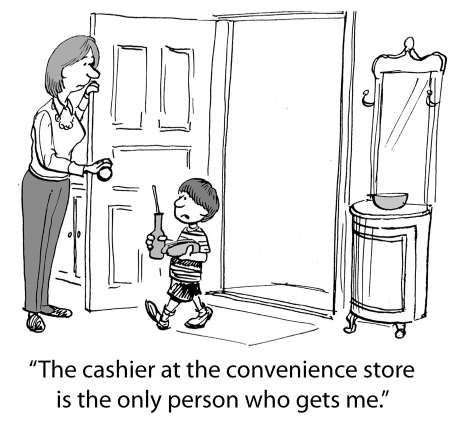Summary
-
There are many ways to slice and dice personality and Myers-Briggs only has 16 so I use it as a shortcut. I find it useful for folks to know what they are because then they can do more of it on purpose (and doing what you’re not is painful, exhausting and miserable).
-
I find the Myers-Briggs personality model useful because it’s:
-
descriptively powerful, giving you comfort and relief that many other people approach life the way you do, and
-
prescriptively powerful, giving you customised, personalised tips and strategies to handle typical problems-of-living.
-
-
If I know your type, I have some idea of:
-
how to most effectively communicate with you.
-
what threats you’re likely to have learned, and
-
-
If you’d like me to help type you, see if we’re a match.
Top photo via Javier Allegue Barros / Unsplash
Find out who you are and do it on purpose.
Dolly Parton
How To Determine Your Type
To determine your type, you only have to answer 4 questions - do the 3 Short Tests below.
If you know yourself well, you’ll get the same result for each test.
It’s my experience that our personality type never changes, even though we can change all our thoughts, memories, beliefs, reactions and behaviours.
I find that context does matter but it doesn’t change anything. People may act “not on type” depending on the current circumstances, but when, for example, they’re bored, they’ll act according to type.
Tip: Respond as if you were bored and it was a normal day.
Tip: If you get stuck, ask someone who knows you well what they would choose for you.
Short Test 1 - Find Your Type In 4 Questions
1) Which applies to you more, E or I:
-
E - Act first, think later
-
I - Think first, act later
2) Which applies to you more, S or N:
-
S - What’s really there? (for example: toasters, clothes and cars exist because they are witnessable in the world); help someone by doing practical things for them (for example: accompany / transport them somewhere, bring them food, fill out a form); disagree with people on things to do which make practical sense.
-
N - What’s not there? (for example: abstractions, concepts, ideas, insights, reasons, implications, causes and predictions are unreal because they are not witnessable in the world); help someone by working something out in conversation; disagree with people on ethical-unethical / moral-immoral / good-bad / right-wrong / worthy-unworthy grounds.
3) Which applies to you more, T or F:
-
T - What works?; you make decisions objectively and you’re most convinced by rational arguments; you don’t take things personally; you argue or debate for fun.
-
F - What’s right?; you decide things based on values and feelings and you’re most convinced by how you feel about something; you take many things personally; you avoid argument and conflict and value harmony and compassion.
4) Which applies to you more, J or P:
-
J - You work on one thing at a time; you like schedules and lists; “I appear to be task-oriented”; “I like to make lists of things to do”; “I like to get my work done before playing”; “I plan work to avoid rushing just before a deadline”; “Other people would describe me as primarily: orderly, structured, decided and seeking closure”; not-knowing drives you crazy.
-
P - You work on many things at a time; you don’t like schedules or lists; “I appear to be loose and casual. I like to keep plans to a minimum”; “I like to approach work as play or mix work and play”; “I work in bursts of energy”; “I am stimulated by an approaching deadline”; “Other people would describe me as primarily: spontaneous, adaptable, curious and open-ended”; not-knowing is kind of fun.
Short Test 2 - Find Your Type In 4 Questions
1) Which applies to you more, E or I:
-
E - Initiating, expressive, gregarious, active, enthusiastic.
-
I - Receiving, contained, intimate, reflective, quiet.
2) Which applies to you more, S or N:
-
S - Concrete, realistic, practical, experiential, traditional.
-
N - Abstract, imaginative, conceptual, theoretical, original.
3) Which applies to you more, T or F:
-
T - Logical, reasonable, questioning, critical, tough.
-
F - Empathic, compassionate, accommodating, accepting, tender.
4) Which applies to you more, J or P:
-
J - Systematic, planful, early-starting, scheduled, methodical.
-
P - Casual, open-ended, pressure-prompted, spontaneous, emergent.
Short Test 3 - Find Your Type In 4 Questions
1) Which applies to you more, E or I:
-
E - “The type of mistake I make more often is acting too fast and impulsively without thinking things through.”
-
I - “The type of mistake I make more often is thinking too much and hesitating before acting.”
2) Which applies to you more, S or N:
-
S - “I’m mainly interested in concrete, observable things happening now and I get annoyed by people who are unconnected to reality with their heads in the clouds.”
-
N - “I’m mainly interested in ideas and concepts and the past and the future and causes and consequences and I get annoyed by people who get hung up on the details and can’t see the forest for the trees.”
3) Which applies to you more, T or F:
-
T - “When I’m deciding something, I think about which decision logically makes the most sense taking into account all the factors.”
-
F - “When I’m deciding something, I weigh which decision is the best one, morally, socially and/or aesthetically.”
4) Which applies to you more, J or P:
-
J - “I make plans in my life and I like to have things decided and I sometimes miss new, important information because I’m so goal-focused.”
-
P - “I take life as it comes and I like to stay open and improvise to respond to what happens and I sometimes miss making necessary decisions because I’m still exploring new information.”
 Image via cartoon resource / Bigstock.com
Image via cartoon resource / Bigstock.com
Basically we are all looking for someone who knows who we are and will break it to us gently.
Robert Brault
The Sixteen Types
-
There are 16 Myers-Briggs types, each described by 4 letters (for example INFP, ESTP, ISFJ). The first letter is either E or I, then S or N, then T or F, then J or P.
-
Roughly, in the population:
-
E occurs 50% and I occurs 50%.
-
S occurs 75% and N occurs 25%.
-
T occurs 40% and F occurs 60%.
-
J occurs 50% and P occurs 50%.
-
-
If the types occurred uniformly frequently, each type would occur at a rate of 1 in 16 (6.25% of the population). But that’s not the case. For example, about 1 in 8 people (12%) types as ISTJ and about 1 in 50 people (2%) types as INFJ.
-
Note: I find it useful to ignore the “cognitive functions” (Fe, Ti, Se, Ni, Fi, Te, Si, Ne). Instead, focus on descriptions of thoughts, emotions and behaviour.
-
Video: The Sixteen Types in Five Minutes - Michael Pierce
Everybody has a secret world inside of them. I mean everybody. All of the people in the whole world - no matter how dull and boring they are on the outside. Inside them they’ve all got unimaginable, magnificent, wonderful, stupid, amazing worlds. Not just one world. Hundreds of them. Thousands, maybe.
Neil Gaiman (Sandman: A Game of You)
Speaking Different Languages Up And Down The Ladder Of Abstraction
 Photo via Piotr Musioł / Unsplash
Photo via Piotr Musioł / Unsplash
The biggest difference between peoples’ types is the second letter (S for Sensor, N for iNtuitive). From the point of view of Intuitives, Sensors can’t see the forest for the trees. From the point of view of Sensors, iNtuitives are off with the fairies.
When a Sensor and an iNtuitive talk, they will believe they are speaking the same language. But they’re actually speaking very different languages.
Sensing versus Intuiting is one of the four Myers-Briggs dichotomies. In the population, Sensing types make up roughly 75%, and Intuiting types make up roughly 25%.
Sensors prefer real things.
Intuitives prefer unreal things.
If we imagine a ladder and at the bottom we put “real things” and at the top we put “unreal things”, we get the Ladder of Abstraction.
The bottom of the ladder is the “South Pole” - the Pole of Representation.
The top of the ladder is the “North Pole” - the Pole of Abstraction.
Representations are real things.
Abstractions are unreal things.
Examples of representations (real, observable, concrete things): “a large, twinkling chandelier”, “a well-designed pen”, “some fine china, “thick, colourful carpets”, “a large, polished dining table”, “a view over the city”.
Example of an abstraction (the unreal containing class): “aesthetically-beautiful surroundings”.
Sensors and intuitives differ in where they prefer to operate on the ladder.
Sensors prefer operating closer to the Pole of Representation. They ask “What is?”
Intuitives prefer operating closer to the Pole of Abstraction. They ask “What isn’t?”
Sensors wanting to be better understood by intuitives need to use more conceptual words (ie. words describing unreal things) to “visit up the ladder”.
Intuitives wanting to be better understood by sensors need to use more concrete words (ie. words describing real things) to “visit down the ladder”.
The Ladder of Abstraction is itself an abstraction because it’s an unwitnessable concept and not a real, witnessable thing. Learning about this, sensors will be bored or impatient or annoyed or dismissive or confused or uncomfortable. Intuitives will be interested and comfortable.
(14 mins) Antonia Dodge PersonalityHacker
“If the world were merely seductive,” he noted, “that would be easy. If it were merely challenging, that would be no problem. But I arise in the morning torn between a desire to improve (or save) the world and a desire to enjoy (or savor) the world. This makes it hard to plan the day.”
Israel Shenker, “E. B. White: Notes and Comment by Author”, The New York Times (11 July 1969)
akhromant
Owen Parachute: The akhromant blog articulates a typing philosophy which I share 100%.
I curate some excerpts below that I think are very important.
THE TYPES ARE THE MOST IMPORTANT, MEANINGFUL AND REAL DIFFERENCES BETWEEN PEOPLE
- Two persons of different types getting on the bus in exactly the same way are doing completely different things, maybe opposite ones, in their own worlds.
THE TYPES HAVE DIFFERENT TALENTS AND LIMITATIONS
-
Every type is the best at some specific (and within itself also broad) thing, and for every type there are also certain impossible [broad] things.
-
This is the whole point of actually getting your type right, as it implies realizing what makes other people truly different from you. Not better or worse, just different.
-
The world we see and the things we value are totally dissimilar from those of other types. We might be looking at the same chair, for example, but we are not thinking anything like the others when it comes to its identity as a single object in relation to that space and other objects in that space, what it’s worth, which other chairs are better or worse, which other things in general would be better or worse, what should be done with it every day, today, tomorrow, as soon as possible, never, if it ever breaks, etc. We see different physical relationships, we make different conceptual connections, we see different possibilities, different movements, problems and solutions, all in different time-frames with different people involved and for different ultimate reasons.
-
Having different types is like having different senses. We can’t see the actions of millions of people, or their value. They are essentially invisible to us because they occur in aspects and levels we will never perceive.
-
Well, those are precisely our beautifully diverse talents. Someone has talent not in the sense that he can do what we like much better than us, but in the sense that we can’t even see that he is doing something, or how he does it.
-
You might live in your own world, but what you admire is the wonder of the others.
TYPING YOURSELF (2): QUESTION WHY
- You don’t try to type yourself out of boredom, peer pressure, or social inertia. You only do it if there’s something that doesn’t fit, or if nothing fits, and you think that this might help you. But you don’t do it only for yourself. This is a very important thing: you do it for everybody, because learning about types is learning about the whole world, and the amazingly diverse ways in which it is perceived and understood by different people who are, in fact, different worlds themselves. Typing is about bringing comprehension, about noticing the unfillable gaps and still managing to feel a larger connection. It doesn’t necessarily mean “acceptance” or “surrender”: it might imply that you need to do or to stop doing something. And there is no fixed/known “result” of typing. It doesn’t automatically follow that you “become a better person” in some definite way. In fact, there is no “becoming”, at all.
I know I’m fortunate to live an extraordinary life, and that most people would assume my business success, and the wealth that comes with it, have brought me happiness. But they haven’t; in fact it’s the reverse. I am successful, wealthy and connected because I am happy.
Richard Branson (Dear Stranger, Letters on the subject of happiness)

